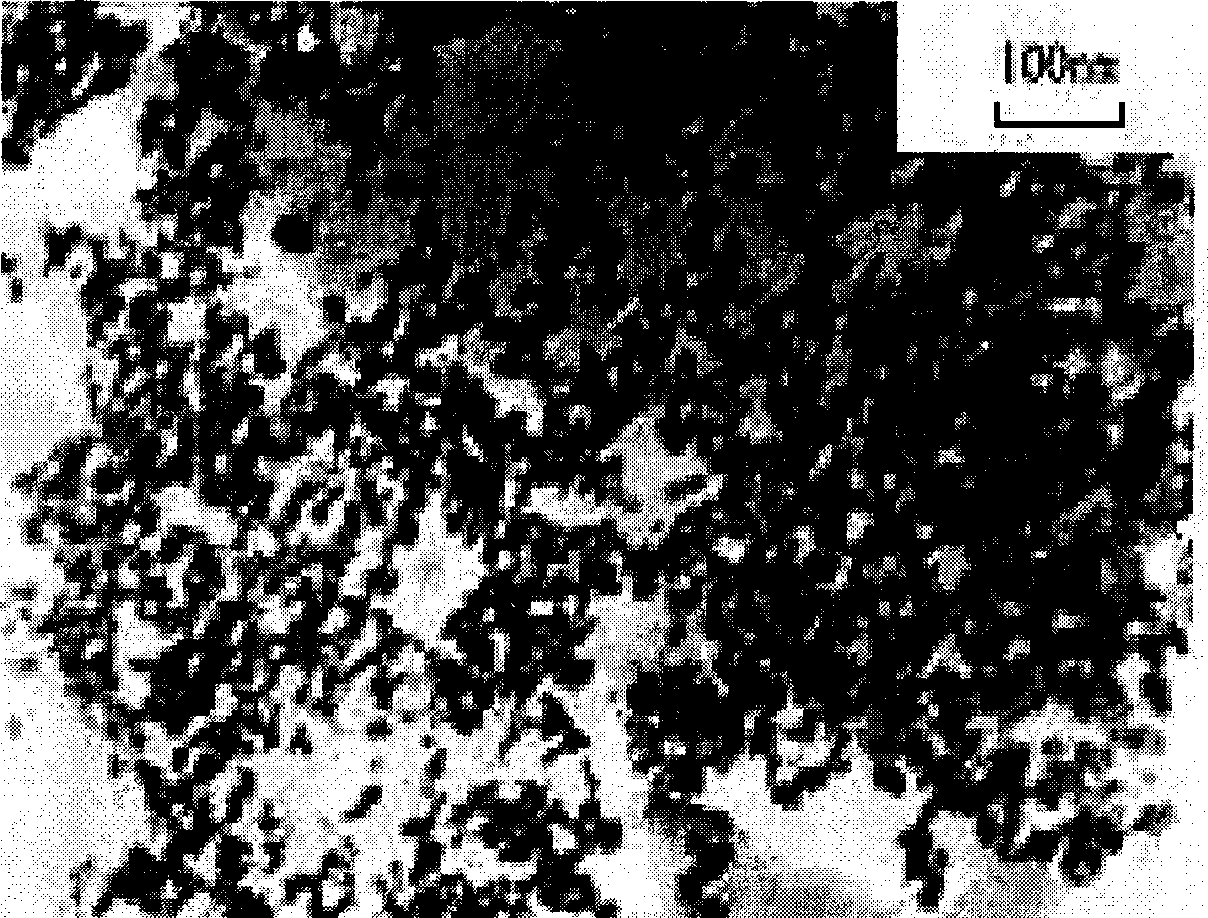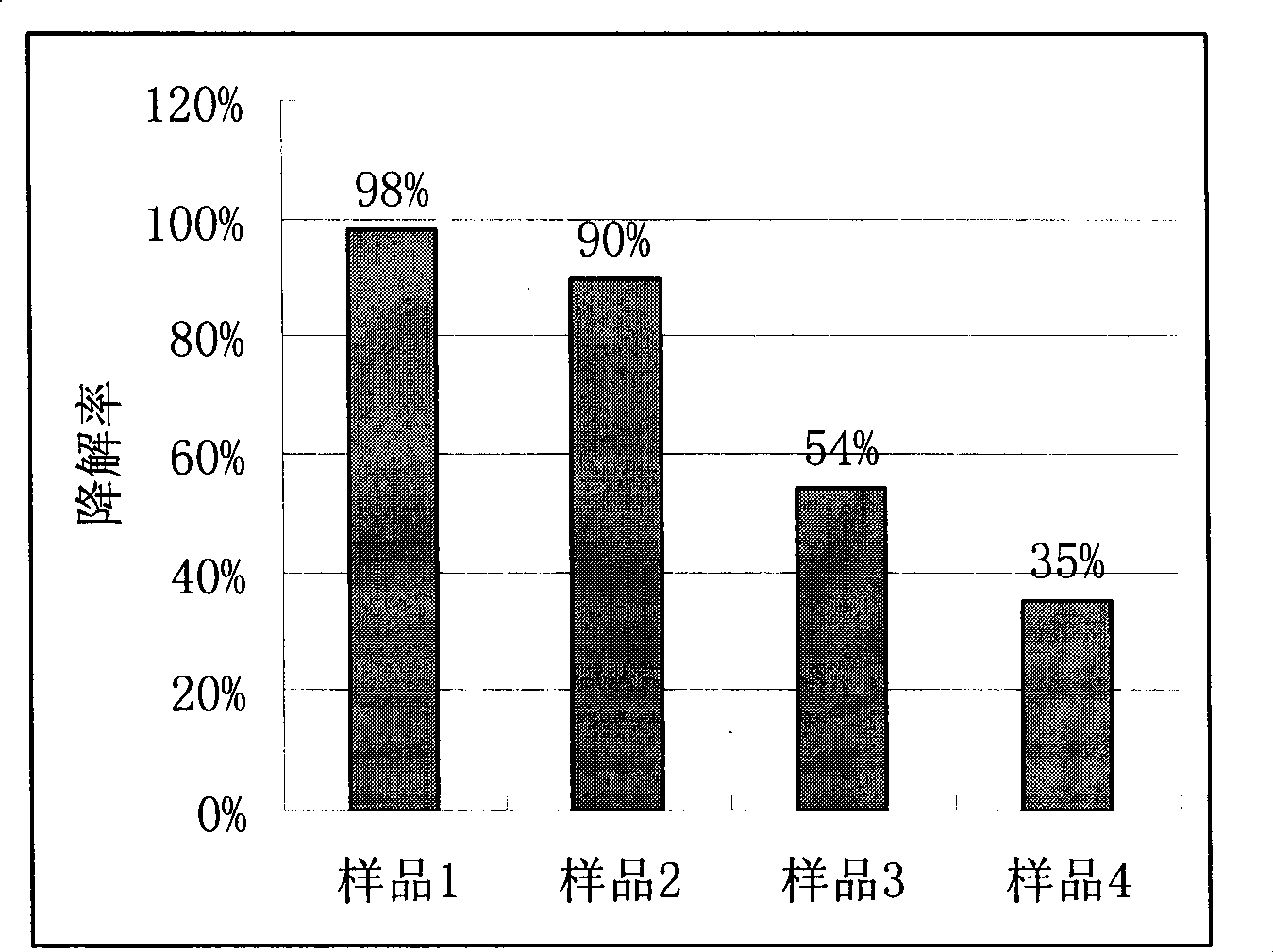Composite metal ion doped with TiO2 photocatalyst transparent emulsion and preparation method thereof
A technology of composite metal ions and photocatalysts, applied in chemical instruments and methods, physical/chemical process catalysts, chemical/physical processes, etc., can solve problems such as poor stability, high energy consumption, and poor dispersion of emulsions, and achieve broad spectrum Response range, improved speed and efficiency, uniform dispersion effect
- Summary
- Abstract
- Description
- Claims
- Application Information
AI Technical Summary
Problems solved by technology
Method used
Image
Examples
Embodiment 1
[0027] (1) At room temperature, measure 33 mL of titanium tetrachloride with a graduated cylinder, and slowly drop it into 100 mL of distilled water to obtain a clear and transparent solution;
[0028] (2) lanthanum nitrate of 4.33 grams and 4.08 grams of cerium sulfate and 1.16 grams of ammonium metavanadate are dissolved in the above-mentioned solution, stir until all dissolving;
[0029] (3) Add pure water to the above solution until the solution is 1000ml, then add 10% ammonia water to the solution, adjust the pH value to 9, and produce a large amount of light yellow precipitate;
[0030] (4) Vacuum filter the above precipitate and wash it with deionized water until it is tested to be free of Cl with silver nitrate solution. - So far, a TiO doped with a molar ratio of metal ions to titanium of 10% has been obtained 2 filter cake;
[0031] (5) Add 2100 ml of water to the above filter cake to make a slurry, cut it with a high-speed shear for 50 minutes, place it in a round...
Embodiment 2
[0034] (1) 4.33 gram of lanthanum nitrate and 4.08 gram of cerium sulfate and 1.16 gram of ammonium metavanadate are dissolved in 250ml water, stir until all dissolve;
[0035] (2) At room temperature, take 110ml of titanium tetrachloride with a graduated cylinder, slowly drop it into the above solution with a separatory funnel to obtain a clear and transparent solution, add pure water until the solution is 1000ml;
[0036] (3) Add 10% ammonia water to the above solution, adjust the pH value to 9, produce a large amount of pale yellow precipitate, vacuum filter the precipitate, wash it with deionized water until it is tested to be free of Cl with silver nitrate solution - So far, TiO with a total molar ratio of doped metal ions to titanium of 3% has been obtained 2 filter cake;
[0037](4) Add 1350 milliliters of water to the above-mentioned filter cake to make a slurry, and after shearing with a high-speed shear for 50 minutes, place it in a round-bottomed flask, add 90ml of...
Embodiment 3
[0040] (1) lanthanum nitrate of 8.66 grams and 8.16 grams of cerium sulfate and 2.32 grams of ammonium metavanadate are dissolved in 500ml water, stir until all dissolve;
[0041] (2) At room temperature, take 110ml of titanium tetrachloride with a graduated cylinder, slowly drop it into the above solution with a separatory funnel, to obtain a clear and transparent solution, add pure water until the solution is 1000ml;
[0042] (3) Add 10% ammonia water to the above solution, adjust the pH value to 8.5, produce a large amount of pale yellow precipitate, vacuum filter the precipitate, wash it with deionized water until it is checked that it does not contain Cl with silver nitrate solution - So far, TiO with a total molar ratio of doped metal ions to titanium of 6% has been obtained 2 filter cake;
[0043] (4) Add 675 milliliters of water to the above-mentioned filter cake to make a slurry, and after cutting for 50 minutes with a high-speed shear, place it in a round-bottomed f...
PUM
 Login to View More
Login to View More Abstract
Description
Claims
Application Information
 Login to View More
Login to View More - R&D
- Intellectual Property
- Life Sciences
- Materials
- Tech Scout
- Unparalleled Data Quality
- Higher Quality Content
- 60% Fewer Hallucinations
Browse by: Latest US Patents, China's latest patents, Technical Efficacy Thesaurus, Application Domain, Technology Topic, Popular Technical Reports.
© 2025 PatSnap. All rights reserved.Legal|Privacy policy|Modern Slavery Act Transparency Statement|Sitemap|About US| Contact US: help@patsnap.com


